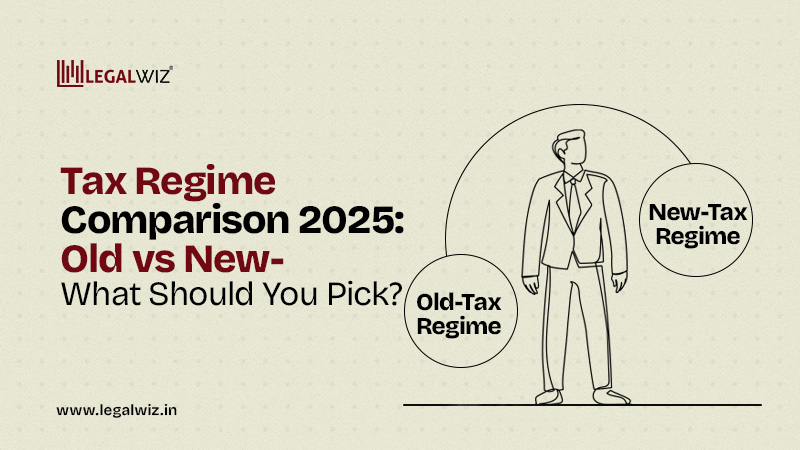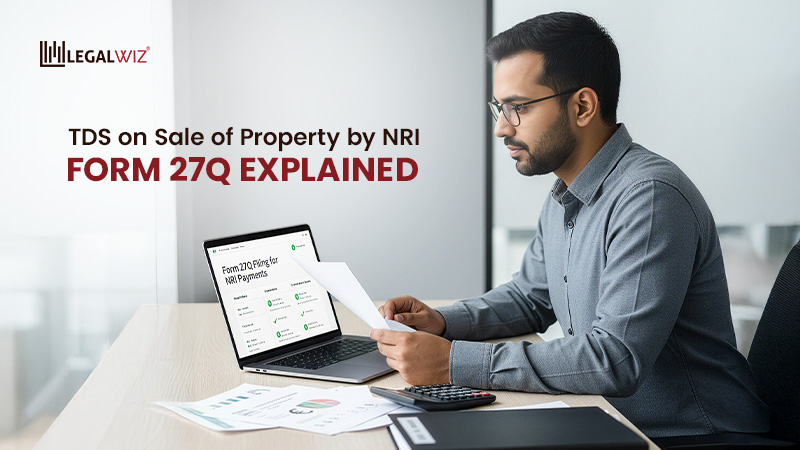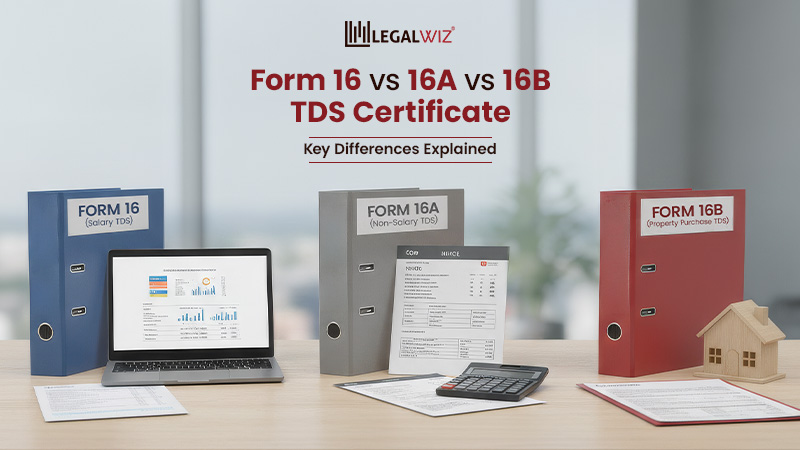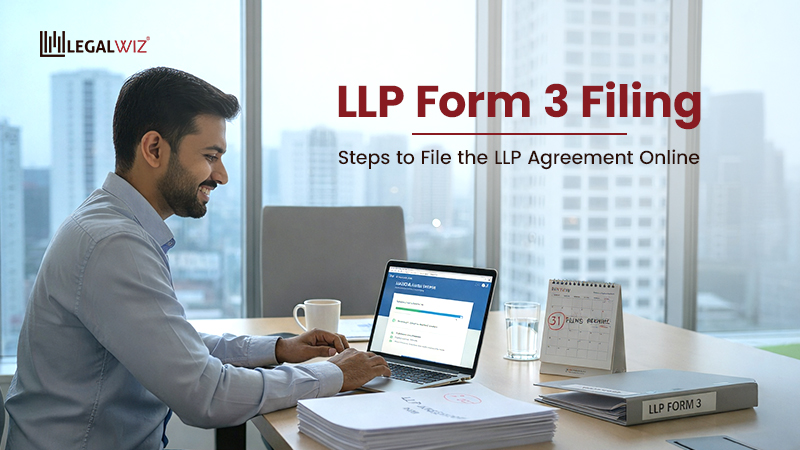Tax Regime Comparison 2025: Old vs New – What Should You Pick?
Welcome to the regime war — where you get to pick your pain (or gain).
Imagine this: you and your colleague earn the exact same salary. But come tax time, their refund is celebratory-chai worthy, and yours feels like a breakup. What gives? Two words: tax regime.
In 2025, the rules for filing your Income Tax Returns are getting a refresh, new slab benefits, updated deductions, and a default switch to the new regime (unless you say otherwise). Translation: the government really wants you to try the no-deductions diet.
But don’t hit “Submit” on your ITR just yet.
This guide is for the salaried savers, the freelance jugglers, the side-hustlers, and anyone who’s stared at a Form 16 like it’s a big puzzle.
Whether you’re a tax-saving pro or just trying to make sense of it all, understanding the basics of income tax concepts and which regime actually works for you is something you absolutely deserve.
Learn more with our Quick Guide for Income Tax Return Filing. It’s all you need to file with confidence!
Spoiler: There’s no one-size-fits-all. But stick around, we’ll help you size up both options, dodge the traps, and walk away with more money in your pocket (or at least fewer regrets).
1. Old vs New Tax Regime: What They Mean for You
Two systems. One income. Very different endings.
Let’s discuss India’s great tax face-off: Old vs New Tax Regime.
(Yes, with the changes in the new income tax rules, we need to discuss the new and old regimes, and what they mean for you.)
For instance, if you’re wondering what the tax is for ₹ 12 lakhs per annum and which path saves you more tax in FY 2025–26, you’re not alone. This choice isn’t just about numbers—it’s about how you save, spend, and invest. Let’s decode both regimes, slab by slab, deduction by deduction.
1.1 The Old Tax Regime: The Classic Option
This is the old and trusted way of doing taxes in India. It gives you many chances to save tax, but only if you invest or spend money in the right places.
Good for: People who save money, plan ahead, and keep their bills or receipts
But: If you don’t invest or don’t do paperwork, you won’t get these benefits.
1.2 The New Tax Regime: The Clean-Slate Option
The new regime is all about being quick and easy. You don’t need to show any investment proofs. In return, the government gives you lower tax rates.
Good for: People who don’t invest much, don’t like paperwork, or just want to keep things simple.
If you’re not using tax-saving schemes, this regime might help you pay less tax without doing anything extra.
1.3 Tax Slab Comparison: Old vs New Regimes (FY 2025–26)
Below is a side-by-side view of income tax rates under both regimes, categorized by age for the old regime and a flat structure for the new regime:
| Annual Income | Old Regime (Below 60 & NRIs) | Old Regime (Age 60–80) | Old Regime (80+ Seniors) | New Regime (All taxpayers) |
| Up to ₹2.5 lakh | Nil | Nil | Nil | Nil |
| ₹2.5L – ₹3L | 5% | Nil | Nil | Nil |
| ₹3L – ₹5L | 5% | 5% | Nil | 5% |
| ₹5L – ₹6L | 20% | 20% | 20% | 5% |
| ₹6L – ₹7L | 20% | 20% | 20% | 5% |
| ₹7L – ₹7.5L | 20% | 20% | 20% | 10% |
| ₹7.5L – ₹9L | 20% | 20% | 20% | 10% |
| ₹9L – ₹10L | 20% | 20% | 20% | 10% |
| ₹10L – ₹12L | 30% | 30% | 30% | 15% |
| ₹12L – ₹12.5L | 30% | 30% | 30% | 20% |
| ₹12.5L – ₹15L | 30% | 30% | 30% | 20% |
| Above ₹15L | 30% | 30% | 30% | 30% |
Note: The same slab rates from FY 2024–25 apply to FY 2025–26 unless announced otherwise in Budget 2025.
1.4 So… Why Is the Government Nudging Us Toward the New Regime?
One word: simplicity.
No paperwork. Fewer errors. Faster returns.
The new regime is clean and quick, great if you don’t claim much. But simple doesn’t always mean smart. You can still opt for the old regime if it saves you more.
That’s why it helps to understand the basics of ITR filing. Even if you’re hiring an expert, being a tax-paying citizen means it’s worth knowing your way around the system.
For example, someone earning ₹12L and claiming full deductions (80C, 80D, NPS, home loan interest) may pay less tax under the old regime than the new.
So before you auto-accept the default, know your numbers. Because of this choice? It’s not just about slabs, it’s about what you gain, and what you lose.
Now, let’s decode the deduction dilemma — and see where your savings really lie.
2. The Deduction Dilemma: What You Gain vs What You Lose
Old Regime = Deduction buffet. New Regime = Less clutter, fewer choices.
Let’s decode what each offers in FY 2025–26.
2.1 Old vs New Tax Regime: What You Can (and Can’t) Claim
| Standard Deduction = ₹75,000 (Now in Both Regimes!) No proofs. No confusion. Just ₹75K off your taxable income. Yes, even in the “no-deductions” regime. |
| Category | Old Regime | New Regime (FY 2025–26) |
| Tax-free income limit | Up to ₹5,00,000 | Up to ₹7,00,000 |
| Flat standard deduction | ₹75,000 | ₹75,000 |
| Tax-free salary threshold (post deductions) | ₹5.5 lakhs | ₹7.75 lakhs |
| Rebate threshold | ₹12,500 | ₹25,000 |
| House Rent Allowance (HRA) | Allowed | Not allowed |
| Leave Travel Concession (LTC) | Allowed | Not allowed |
| Meal and other regular allowances | Allowed (subject to limits) | Not allowed |
| Standard deduction for salaried/pensioners | Yes | Yes |
| Professional tax and entertainment allowance relief | Allowed | Not allowed |
| Work-related perquisites (e.g., laptop, travel) | Exempt | Exempt |
| Interest on home loan (self-occupied) | Deductible | Not allowed |
| Interest on home loan (rented property) | Deductible | Deductible |
| Investments under Section 80C (LIC, PPF, ELSS, etc.) | Deductible | Not permitted |
| Own NPS contributions (80CCD(1B)) | Deductible | Not permitted |
| Employer’s NPS contribution (80CCD(2)) | Deductible | Deductible |
| Health insurance premiums (80D) | Deductible | Not permitted |
| Disability deductions (80U) | Available | Not available |
| Education loan interest (80E) | Deductible | Not allowed |
| Electric vehicle loan interest (80EEB) | Deductible | Not allowed |
| Donations (Section 80G) | Deductible | Not allowed |
| Savings interest (80TTA/80TTB) | Deductible | Not available |
| Other Chapter VI-A deductions | Available | Not available |
| Agniveer Corpus Fund (80CCH) | Allowed | Allowed |
| Family pension relief | Up to ₹15,000 | Up to ₹25,000 |
| Gifts received (up to ₹50,000) | Exempt | Exempt |
| VRS payout exemption (Section 10(10C)) | Exempt | Exempt |
| Gratuity exemption (Section 10(10)) | Exempt | Exempt |
| Leave encashment (Section 10(10AA)) | Exempt | Exempt |
| Daily allowance (for travel/duty) | Exempt | Exempt |
| Conveyance allowance | Exempt | Exempt |
| Transport allowance for differently-abled employees | Exempt | Exempt |
In the old regime, smart spending = smart saving. But it takes receipts, records, and some financial discipline.
2.2 Can You Still Save Tax in the New Regime?
Surprise — the new regime isn’t a complete deduction blackout. While big-ticket claims like 80C and 80D are off the table, some key benefits still survive — especially for FY 2025–26.
What’s Still Allowed under New Regime:
| Benefit | Details |
| Employer’s NPS Contribution | Up to 10% of salary (Section 80CCD(2)) |
| Interest on Rented Property | Fully deductible |
| EPF, Gratuity, VRS | Exempt as per standard rules |
| Transport Allowance (disabled employees) | ₹3,200/month |
You still get relief if your employer contributes, you own a let-out property, or you’re receiving retirement benefits.
2.3 Old vs New: What Should You Pick?
It’s simple:
- Old Regime wins if you’re claiming ₹3–4L+ in deductions — ELSS, EMIs, insurance, HRA, etc.
- New Regime works better if you don’t invest much or just want a hassle-free, clean break from paperwork.
For someone earning ₹12L, the best regime depends on one thing: are you using your deductions well enough to make them count?
Next: Let’s run the numbers and see who really saves more.
3. Taxpayer Guide: Who Should Choose What
Not all taxpayers wear the same suit — or even care for one. So why should they pick the same tax regime?
Want to know where you fit in the taxpayer universe? Get toknow the various types of taxpayers in India and see how your profile impacts your tax strategy.
It’s not just about slabs. It’s about how you earn, save, and file. Let’s match your profile to the right regime for FY 2025–26:
3.1 Old Regime vs New Regime – Who Should Choose What? (FY 2025–26)
| Taxpayer | Old Regime If… | New Regime If… | Pro Tip |
| Salaried | You claim HRA, insurance, ELSS, or home loan benefits | No tax-saving investments, prefer clean filing | Deductions over ₹2.5L? Stick with old |
| Freelancers | You claim real expenses (laptop, rent, travel) | You use 44ADA or keep it simple | Under ₹20L with low spend? New works |
| Seniors | You invest, claim medical expenses, or use FD interest | No deductions, prefer ease | Don’t go by age — go by numbers |
| Business Owners | You track actual expenses, maintain books | You opt for presumptive taxation (44AD/ADA) | Can’t easily switch regimes — decide wisely |
Key Takeaways:
- More deductions = Old Regime wins
- No deductions or simple income = New Regime is smoother
- Standard deduction of ₹50,000 is now in both regimes
- Run the numbers using a calculator before filing — small differences can mean big savings
4. Real-Life Tax Calculations: Who Saves More?
Theory is cute, but math decides the winner.
You’ve heard the pitch. The old tax regime offers a buffet of deductions like Section 80C, 80D, HRA, and more. The new tax regime offers lower slab rates and a cleaner experience — with fewer tax-saving tools.
But what does it all mean in rupees?
Let’s plug in some real-world income levels and compare how much income tax you’d actually pay under both systems in FY 2025–26/AY 2026–27.
We’re keeping it simple, practical, and focused on salaried individuals—especially those earning between ₹7 lakh and ₹25 lakh.
Income Levels We’ll Compare:
| Scenario | Income Level |
| Case 1 | ₹7 lakh |
| Case 2 | ₹10 lakh |
| Case 3 | ₹15 lakh |
| Case 4 | ₹25 lakh |
For each, we’ll show:
- Tax under Old Regime (assuming average deductions like 80C + 80D + HRA)
- Tax under New Regime (with standard deduction of ₹75,000 only)
- Effective Tax Rate
- Who Wins & Why
4.1 Tax Showdown: Old Regime vs New Regime (FY 2025–26)
| Annual Income | Old Regime | New Regime | ETR (Old vs New) | Winner & Why |
| ₹7L | ₹2L deductions Taxable: ₹5L Tax: ₹0 (87A rebate) | ₹75K deduction Taxable: ₹6.5L Tax: ₹0 (rebate up to ₹7L) | 0% vs 0% | Tie – Rebate under 87A applies in both |
| ₹10L | ₹2.5L deductions Taxable: ₹7.5L Tax: ₹52,500 | ₹75K deduction Taxable: ₹9.5L Tax: ₹39,000 | 5.25% vs 3.9% | New – Lower slabs beat minor deductions |
| ₹15L | ₹3.5L deductions Taxable: ₹11.5L Tax: ₹1,35,000 | ₹75K deduction Taxable: ₹14.5L Tax: ₹1,45,600 | 9% vs 9.7% | Old – 80C + HRA just tip the scale |
| ₹25L | ₹4L deductions Taxable: ₹21L Tax: ₹4,57,200 | ₹75K deduction Taxable: ₹24.5L Tax: ₹4,62,000 | 18.3% vs 18.5% | Old – Higher deductions still add up |
| → Note | Your deductions and income profile decide the winner. Even ₹1–2L in deductions can flip the result. |
Who Should Pick What?
- Under ₹7L? Don’t stress. Both regimes = zero tax.
- Around ₹10L? If you’re not investing much, new regime wins.
- ₹12–₹15L? A few deductions (80C, 80D, housing) can tilt things toward the old regime.
- ₹20L+? If you’re serious about deductions, old regime still holds strong.
From AY 2025–26 onward, both regimes offer ₹75K standard deduction — but only the old regime keeps juicy extras like 80C, 80D, HRA, LTA, and more.
Pro Tip: Run Your Own Numbers
Use a tax calculator or simulate your return on the Income Tax Portal. Even a quick Excel check can uncover ₹20,000+ in savings.
5. Decision Time: Old vs New – A Checklist Before You Lock In
So far, we’ve danced with slabs, waded through deductions, and sized up tax types by profession. Now it’s time to bring it all home.
Which tax regime is better in 2025? That depends entirely on you — your income, your habits, and how much paperwork you’re willing to tolerate.
Use this quick checklist to make the call before you file your income tax return for FY 2025–26.
5.1 Old vs New Tax Regime: Quick Checklist (FY 2025–26)
Not sure which regime to choose? This mini decision-maker will help you out:
| Ask Yourself… | If YES | If NO |
| Claiming ₹2.5L+ in deductions? | Go Old Regime — you’ll save more. | New Regime might suit better. |
| Claiming HRA or home loan interest? | Old gives full benefits. | New skips the paperwork. |
| Income changes yearly (bonus, freelance)? | Old helps if you plan smart. | New = no guesswork. |
| Using 80D (health), 80E (loan), 24(b)? | Stick with Old Regime. | New is cleaner, but no extras. |
Tip: New regime is the default from FY 2025–26, but you can switch to old while filing.
5 minutes of comparison = ₹10K–₹50K saved.
6. Final Thoughts: Make Your Tax Regime Work for You, Not Against You
Picking a tax regime isn’t about loyalty — it’s about logic.
Yes, the new regime is now the default, but that doesn’t make it the right fit for you. Your decision should match your financial habits, not someone else’s spreadsheet.
- Love tax-saving tools like 80C, HRA, and health insurance?
→ The Old Regime could be your perfect partner. - Prefer simplicity and fewer proofs to collect?
→ The New Regime keeps things breezy.
But whatever you choose — don’t default blindly.
Run the numbers. Use a calculator. Ask your CA. Even a 10-minute check could save you thousands.
Still unsure?
Jump back to the checklist in Section 5 — it’s designed to clear the fog.
Need help filing the right way?
Want to skip the tax math and just file stress-free? Let LegalWiz.in handle your ITR, start to finish. Filing done right, on time, every time.
Frequently Asked Questions
Which tax regime is better: old or new?
That depends. Are you a deduction hoarder or a set-it-and-forget-it type? If you’re into 80C investments, insurance premiums, and home loans, the old regime could save you more. But if you hate paperwork and prefer a cleaner, no-frills route, the new regime is your low-maintenance BFF.
Can I switch between the old and new regimes every year?
If you’re salaried, yes, you can switch sides every financial year. Running a business or freelancing full-time? You only get one regime flip, unless you give up business income altogether. Choose wisely, tax warrior.
What’s the default tax regime for FY 2025–26?
The new regime is the cool new default. But don’t worry, if the old one suits you better, you can still opt in manually while filing your ITR. Just don’t forget to tick that box!
Are deductions like Section 80C allowed under the new regime?
Not really. The new regime is allergic to most deductions; 80C, 80D, HRA, and LTA are not allowed. But a few goodies remain: standard deduction, employer’s NPS contribution, and the Agniveer Corpus Fund (80CCH) still make the cut.
I earn ₹12 lakhs annually. Which regime will save me more tax?
If you’ve maxed out your deductions (80C, 80D, NPS, home loan), the old regime might be your money-saver. If not, the new regime’s lower rates could keep your tax bill leaner. Moral of the story: let the math decide!
What’s the standard deduction under the new tax regime?
As of FY 2024–25, you get a ₹75,000 standard deduction, no questions asked, if you’re salaried or drawing a pension. It’s like a little gift from the tax gods, available under both regimes.
Can I change my tax regime after filing my ITR?
Sadly, no. Once you hit submit, you’re locked in for the year. So don’t speed-run your return. Compare, calculate, and then commit.

Sapna Mane
Sapna Mane is a skilled content writer at LegalWiz.in with years of cross-industry experience and a flair for turning legal, tax, and compliance chaos into clear, scroll-stopping content. She makes sense of India’s ever-changing rules—so you don’t have to Google everything twice.







